Abstract
In an earlier investigation of those mechanisms which synchronize the leg movements of a multilegged animal during walking (Müller and Cruse 1991) several questions remained open. The movement of an individual leg can be described in analogy to the behaviour of a relaxation oscillator. Following this analogy the interactions between the legs can be compared with the interactions between coupled relaxation oscillators. To understand the behaviour of a system of such coupled oscillators, model calculations were performed by systematically varying the relation of the intrinsic frequencies and the character as well as the strength of the coupling influences to which each oscillator was exposed. The behaviour of several three- and four-oscillator systems was investigated. We found that prediction of the behaviour is often difficult and in some cases even counter-intuitive. It could be shown that in a four-oscillator system (which corresponds to two legs on the left and two legs on the right side of the body) diagonal neighbours can sometimes be more strongly coordinated than direct segmental neighbours, although no coupling was implemented between the diagonally neighbouring oscillators. Necessary conditions for the occurrence of this effect are described. These conditions were fulfilled in the biological experiments described in Part I. A four-oscillator model whose properties are adapted to those found in the above experiments can sufficiently describe the animal's behaviour.
Similar content being viewed by others
References
Bässler U (1986) On the definition of central pattern generator and its sensory control. Biol Cybern 54:65–69
Batschelet E (1983) Circular statistics in biology. Academic Press, London New York
Clarac F (1982) Decapod crustacean leg coordination during walking. In: Herreid CF II, Fourtner C (eds) Locomotion and energetics in arthropods. Plenum Press, New York London, pp 31–71
Clarac F, Barnes WJP (1985) Peripheral influences on the coordination of the legs during walking in decapod crustaceans. In: Bush BMH, Clarac F (eds) Coordination of motor behaviour. University Press, Cambridge, pp 249–269
Cruse H (1990) What mechanisms coordinate leg movements in walking arthropods? TINS 13:15–21
Cruse H, Graham D (1985) Models for the analysis of walking in arthropods. In: Bush BMH, Clarac F (eds) Coordination of motor behaviour. University Press, Cambridge, pp 281–301
Cruse H, Müller U (1986) Two coupling mechanisms which determine the coordination of ipsilateral legs in the walking crayfish. J Exp Biol 121:349–369
Delcomyn F (1985) Factors regulating insect walking. Ann Rev Entomol 30:239–256
Graham D (1985) Pattern and control of walking in insects. In: Advances in insect physiology, vol 18. Academic Press, London, pp 31–140
Holst E von (1939/1973) Relative coordination as a phenomenon and as a method of analysis of central nervous function. Reprinted in: The collected papers of Erich von Holst, University of Miami Press, Coral Gables, Fla
Müller U, Cruse H (1991) The contralateral coordination of walking legs in the crayfish Astacus leptodactylus. I. Experimental results. Biol Cybern 64:429–436
Pavlidis T (1973) Biological oscillators: their mathematical analysis. Academic Press, London New York
Stein PSG (1976) Mechanisms of interlimb phase control. In: Hermann RM, Grillner S, Stein PSG, Stuard DG (eds) Neural control of locomotion. Plenum Press, New York London, pp 465–487
Author information
Authors and Affiliations
Rights and permissions
About this article
Cite this article
Müller, U., Cruse, H. The contralateral coordination of walking legs in the crayfish Astacus leptodactylus . Biol. Cybern. 64, 437–446 (1991). https://doi.org/10.1007/BF00224711
Received:
Accepted:
Issue Date:
DOI: https://doi.org/10.1007/BF00224711
